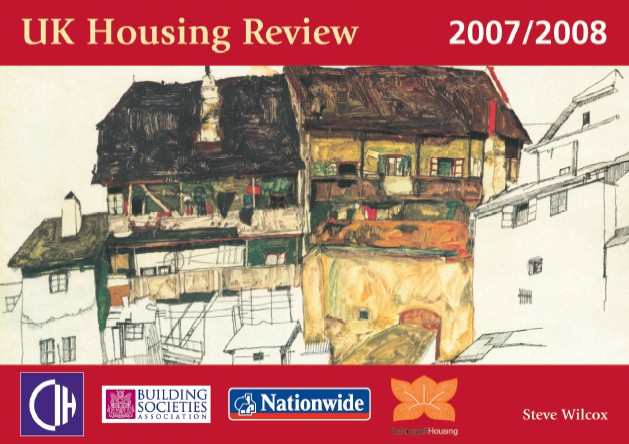
UK HOUSING REVIEW 2007/2008

INTRODUCTION
| PAST EDITION |
| 2007/2008 |
| ACKNOWLEDGEMENTS |
| INTRODUCTION |
| COMMENTARY |
| COMPENDIUM |
| ALL EDITIONS |
| 2025 |
| 2024 |
| 2023 |
| 2022 |
| 2021 |
| 2020 |
| 2019 |
| 2018 |
| 2017 |
| 2016 |
| 2015 |
| 2014 |
| 2013 |
| 2011/12 |
| 2010/11 |
| 2009/10 |
| 2008/9 |
| 2007/8 |
| 2006/7 |
| 2005/6 |
| 2004/5 |
| 2003/4 |
| < 2003 |
| UKHR HOME |
| CONTACT |
The primary objective of this, the 16th edition of the UK Housing Review (initially called the Housing Finance Review), remains simply to draw together key current financial and related data about both public and private housing in the United Kingdom, and rapidly assemble them in a coherent and accessible format.
To that end the Review draws on a wide range of Expenditure Plans and Departmental Reports, as well as statistical volumes, survey reports, and other more occasional research reports. The Review also includes several tables constructed from databases that are not routinely published elsewhere.
This online version of the Review includes the majority of the material contained in the print version. As in previous years, it does not feature Section 1 - the contemporary issues articles which begin the print Review. This year those four articles focus on the government’s plans to increase the supply of market and affordable housing in England; the formation of house price expectations; the volatility of the housing market in Northern Ireland, and the failings of housing benefit as an in-work benefit.
The six chapters of Section 2: Commentary, offer a brief introduction and discussion of the key developments in policy, financial provision and output, that are reflected in the tables and figures in the main Compendium of tables. It also provides a reference to other publications and data that provide further useful insights into current policy issues.
A longer perspective
Many of the tables in the Review provide data over a long time period. Wherever possible those tables start in 1970, providing data at five year intervals for the years to 1990, and with annual data for more recent years. The precise range of the years covered varies slightly from table to table, depending both on data availability, and the practicality of setting out data on a single page. Even with its landscape format there are limits to the number of years’ data that the Review can fit on to a single page.
Readers can consult earlier editions of the Review for data for the individual years between 1981 and 1989 that are no longer published in the current edition. However, readers should exercise care as in some cases data for those earlier years may have subsequently been subject to revisions, primarily as a result of changes in definitions. A cross check of the data for those years still published in the current edition of the Review will generally indicate whether or not this is an issue.
Regions
The Review contains several tables providing data for the regions of England. Many of those tables provide data for the long established standard statistical regions. Government statistics are, however, now being published primarily on the basis of government office regions. This presents difficulties in providing a consistent long run of regional data. In this period of transition, wherever possible current data for standard regions has been sought, in order to provide a consistent data series. This has not, however, always been possible. Equally, long back series of data for government office regions are not always available. In some cases, therefore, the Review includes recent data for government office regions, together with earlier data for standard regions. This is clearly indicated in the tables concerned.
There has also been a change in the nomenclature of government office regions. The Eastern region is now known as the East of England, and Yorkshire and Humberside is now known as Yorkshire and The Humber. In this year’s Review the government office regions are generally shown under their new names. However, the new names are not always used in our source documents or datasets, and we have followed the practice in the latest editions of our sources, rather than impose a uniform usage.
The North West government office region now includes Merseyside, and in many cases separate figures for Merseyside are no longer available. However, where Merseyside figures continue to be available these continue to be provided in the Review.
Government departments
Over the course of time government departments are restructured or simply change their name. Thus, over the years of the Review’s publication the department responsible for housing policy in England has evolved from the Department of the Environment, through the Department for Environment, Transport and the Regions, and the Office of the Deputy Prime Minister, to now the more simply named Communities and Local Government.
Where data series have been made available continuously over that period the reference given for those data in the tables of the Review is the current form and name of the responsible department. Where, however, reference is made to historical data the reference will be to the form and name of the responsible department at the time the data were initially published, or otherwise made available to the Review.
Comments and suggestions
Finally, the editor would welcome any comments or suggestions on the current and future format and contents of the Review, and he can be contacted by email or letter
© UK Housing Review | Cookie Policy | CIH Privacy Policy